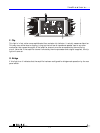
10
6.0 Indicators
A. AC Present
This light glows when AC power is applied to the amplifier, whether or not the amplifier is actually
running. This light will still glow even if the rear panel fuse is blown because it is powered from the
separate, internally fused supply that powers the microprocessor.
B. Operate
Illuminated when the main power supply is switched on using the front panel switch.
C. Fault
If, for any reason, the microprocessor detects a problem then this light comes on. If it is not flashing the
problem is with one or more of the amplifier channels. If it flashes, the processor has been unable to start
the main power supply; this may be because the power supply has become too hot, or because the rear
panel fuse has failed. If letting the amplifier cool and/or replacing the fuse does not clear the problem,
the amplifier must be returned to an authorized service center for repair.
Under some circumstances, the Fault light might flash with a period of about 3 seconds along with the
Power light and various clicking noises. This is because the processor is trying to power up the amplifier
but is detecting an error, aborting, and then retrying. This may either continue indefinitely (for example a
shorted output in bridge mode) or stop after a number of attempts.
D. Temp 1&2
These lights come on if the microprocessor detects that the corresponding channel’s heatsink has
exceeded the maximum allowed temperature. If the light is on, that channel will have been muted. Once
the heatsink has cooled, normal operation will resume. This cycling will be allowed to continue
indefinitely.
During normal to heavy use, the substantial heatsinks used in PULSE amplifiers should ensure that these
lights never come on, however if the front air intakes, rear air exhausts or any fan filters fitted become
blocked an over temperature condition may occur.
E. Signal
This indicator lights when a signal exceeding approximately -26dBu is applied to a channel. In bridge
mode only the light for channel 1 operates.


















